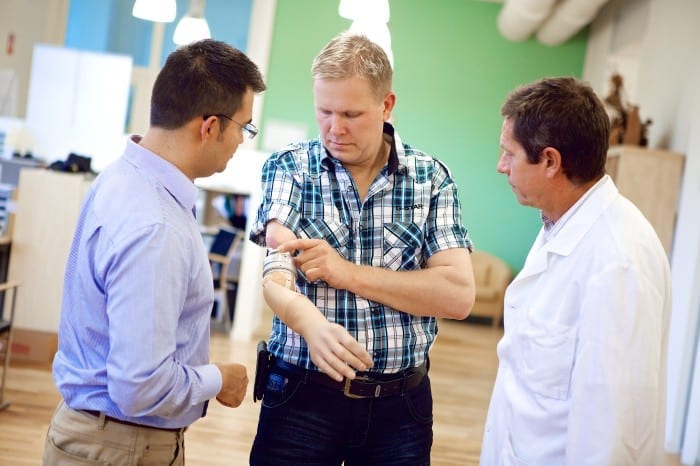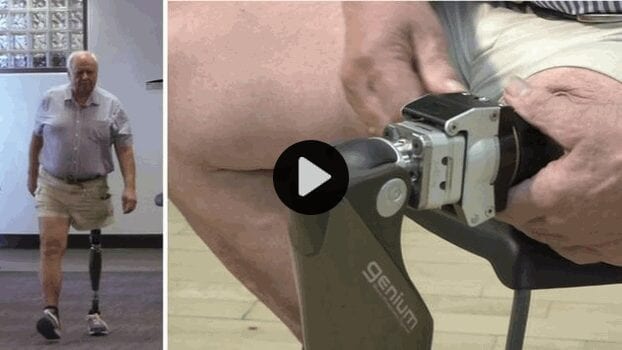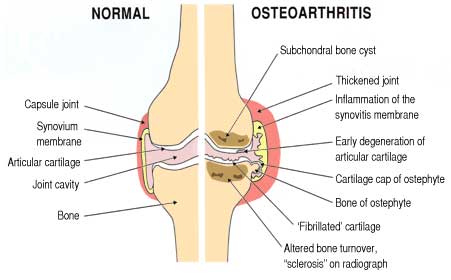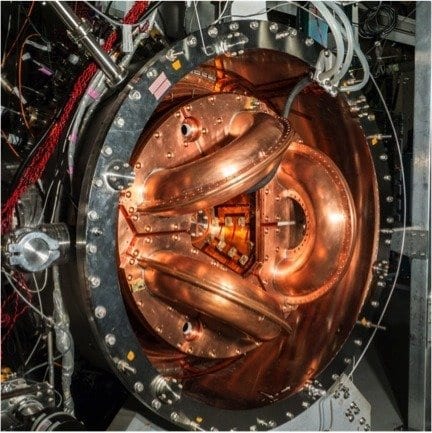
For the first time, robotic prostheses controlled via implanted neuromuscular interfaces have become a clinical reality. A novel osseointegrated (bone-anchored) implant system gives patients new opportunities in their daily life and professional activities.
In January 2013 a Swedish arm amputee was the first person in the world to receive a prosthesis with a direct connection to bone, nerves and muscles. An article about this achievement and its long-term stability will now be published in the Science Translational Medicine journal.
“Going beyond the lab to allow the patient to face real-world challenges is the main contribution of this work,” says Max Ortiz Catalan, research scientist at Chalmers University of Technology and leading author of the publication.
“We have used osseointegration to create a long-term stable fusion between man and machine, where we have integrated them at different levels. The artificial arm is directly attached to the skeleton, thus providing mechanical stability. Then the human’s biological control system, that is nerves and muscles, is also interfaced to the machine’s control system via neuromuscular electrodes. This creates an intimate union between the body and the machine; between biology and mechatronics.”
The direct skeletal attachment is created by what is known as osseointegration, a technology in limb prostheses pioneered by associate professor Rickard Brånemark and his colleagues at Sahlgrenska University Hospital. Rickard Brånemark led the surgical implantation and collaborated closely with Max Ortiz Catalan and Professor Bo Håkansson at Chalmers University of Technology on this project.
The patient’s arm was amputated over ten years ago. Before the surgery, his prosthesis was controlled via electrodes placed over the skin. Robotic prostheses can be very advanced, but such a control system makes them unreliable and limits their functionality, and patients commonly reject them as a result.
Now, the patient has been given a control system that is directly connected to his own. He has a physically challenging job as a truck driver in northern Sweden, and since the surgery he has experienced that he can cope with all the situations he faces; everything from clamping his trailer load and operating machinery, to unpacking eggs and tying his children’s skates, regardless of the environmental conditions (read more about the benefits of the new technology below).
The patient is also one of the first in the world to take part in an effort to achieve long-term sensation via the prosthesis. Because the implant is a bidirectional interface, it can also be used to send signals in the opposite direction – from the prosthetic arm to the brain. This is the researchers’ next step, to clinically implement their findings on sensory feedback.
The Latest on: Mind-controlled prosthetic arms
[google_news title=”” keyword=”Mind-controlled prosthetic arms” num_posts=”10″ blurb_length=”0″ show_thumb=”left”]
via Google News
The Latest on: Mind-controlled prosthetic arms
- 'Elden Ring' Fans Get Weird About Bandai Namco Selling A Life-Sized Replica Of Malenia's Prosthetic Armon April 26, 2024 at 10:27 am
It is FromSoftware's second recent "bruh moment" merch drop after the company released "18 inches of Messmer." ...
- Moving the conversation about obesity beyond the scaleon April 19, 2024 at 1:30 am
Millions of Americans struggling with obesity need ways to lose weight that benefit the body as a whole, not just whittle away body fat.
- Boy's £20k fundraising attempt for prosthetic armon April 10, 2024 at 5:00 pm
The family of an 11-year-old boy is trying to raise £20,000 towards an advanced prosthetic arm. The Hero Arm has multi-grip functionality for people with a below-elbow limb difference ...
- Marine who lost arm in Afghanistan makes his own superhero-like prosthetic — now he can lift up to 400 lbson April 4, 2024 at 8:51 am
An ex-Marine and father of one who lost an arm in Afghanistan got his power back — and then some — after receiving a custom-made, superhero-like prosthetic replacement that can lift up to 400 ...
- Frisco middle schooler invents an affordable prosthetic armon April 2, 2024 at 3:28 pm
"I witnessed a young boy without an arm, and I realized that he didn't have a prosthetic," Siddarth said. He said the boy's family could not afford a prosthetic arm for their child. Siddarth ...
- ‘Bionic woman’ is first to have robotic limb merged with bone — and controlled with her mindon October 11, 2023 at 10:29 am
Meanwhile, the existing prosthetic ... arm has been “life changing,” reducing her phantom pain and allowing her to regain independence and participate in everyday life. “I now have better ...
- Above-the-elbow amputee ‘moves individual fingers in bionic limb in world first’on July 12, 2023 at 11:20 am
A man who lost his left arm in a work accident is now able to control each ... into movement of the prosthetic, enabling Tonney to move his bionic hand using his mind. Prof Ortiz Catalan said ...
- Adding A Gentle Touch To Prosthetic Limbs With Somatosensory Stimulationon June 30, 2021 at 4:29 am
This left him initially at the age of 18 years old to consider a life without the use of his arms or legs ... At the core of these brain-controlled prosthetics we find the brain-computer interface ...
- Scientists develop system that allows prosthetic hands to mimic feelingon March 14, 2018 at 3:51 pm
However, there are still a few ways in which even the most high-tech artificial arms and legs come ... had previously had surgery to make mind-controlled prosthetics a possibility for them.
- Mind-controlled prosthetic arm plays the pianoon September 4, 2007 at 5:00 pm
has launched a $55-million project that pools the efforts of prosthetics experts nationwide to create a thought-controlled bionic arm that duplicates the functions of a natural limb. If all goes ...
via Bing News










